Peer Reviewed Publications by Kisha Supernant
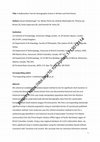
Proceedings of the National Academy of Science USA, 2017
We extend an established simulation-based method to test for significant short-duration (1–2 cent... more We extend an established simulation-based method to test for significant short-duration (1–2 centuries) demographic events known from one documented historical and one oral historical context. Case study 1 extrapolates population data from the Western historical tradition using historically derived demographic data from the catastrophic European Black Death/bubonic plague (Yersinia pestis). We find a corresponding statistically significant drop in absolute population using an extended version of a previously published simulation method. Case study 2 uses this refined simulation method to test for a settlement gap identified in oral historical records of descendant Tsimshian First Nations communities from the Prince Rupert Harbour region of the Pacific Northwest region of British Columbia, Canada. Using a regional database of n = 523 radiocarbon dates, we find a significant drop in relative population using the extended simulation-based method consistent with Tsimshian oral records. We conclude that our technical refinement extends the utility of radiocarbon simulation methods and can provide a rigorous test of demographic predictions derived from a range of historical sources.
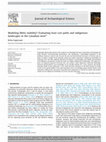
Journal of Archaeological Science, 2017
Geographic Information Systems (GIS) analyses in archaeology have been criticized by archaeologis... more Geographic Information Systems (GIS) analyses in archaeology have been criticized by archaeologists for being reductive, environmentally deterministic, and reproducing a disembodied experience of the landscape. However, research over the past 20 years has demonstrated the power of GIS data and analyses to explore complex social questions about past human experiences. Indigenous knowledges of landscapes have not often explicitly informed GIS analyses in archaeology, even though archaeologists and indigenous communities around the world are forging collaborative relationships. This paper proposes an integrated approach GIS-based least cost analysis, where Indigenous traditional knowledge, historical documentation, and archaeology can be brought together for a more nuanced and locally-grounded model of past landscapes. A case study from the movement of the M etis people of Canada is used to test typical models of cost path movement used in archaeology against known historic trails information, followed by a discussion of possible future applications of movement models and variables related to local Indigenous knowledge of current and past landscapes.

Small villages have been central to progressive models of hunter-gatherer-fisher complexity on th... more Small villages have been central to progressive models of hunter-gatherer-fisher complexity on the Northwest Coast as a stage in the narrative of increasingly nonegalitarian social relations. We argue that Tsimshian settlement history is more complicated. We examine settlement and chronological data for 66 village sites in the Tsimshian area, 22 of which we define as small. Small villages were present in the area as early as 6500 years ago, but they are also contemporary with larger settlements until after 1300 years ago. We suggest that small villages represent a traditional Tsimshian social entity known as the wilnat'aał, or lineage, knowledge of which is preserved in Tsimshian oral records. We argue that the persistence of this settlement and community form illustrates the foundational role of this social unit throughout Tsimshian history, a result that has implications for archaeological research in the context of Indigenous history.

Prince Rupert Harbour (PRH), on the north Pacific Coast of British Columbia, contains at least 15... more Prince Rupert Harbour (PRH), on the north Pacific Coast of British Columbia, contains at least 157 shell middens, of which 66 are known villages, in an area of approximately 180 km2. These sites span the last 9500 yr and in some cases are immense, exceeding 20,000 m2 surface area and several meters in depth. Recent archaeological research in PRH has become increasingly reliant on radiocarbon dates from marine shell for developing chronologies. However, this is problematic as the local marine reservoir effect (MRE) remains poorly understood in the region. To account for the MRE and to better date the Harbour’s sites, we propose a ΔR of 273±38 for the PRH area, based on our work at the site of Kitandach (GbTo-34), a massive shell midden-village centrally located within the Harbour. We followed the multiple paired sample approach for samples from specific contexts and ensured contemporaneity within the groups of marine and terrestrial materials by statistically assessing for outliers using the χ2 test. Taking together, the results for this and previous studies, it appears the MRE was fairly constant over the past 5000 yr.
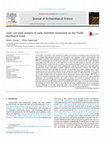
In this paper, we present a new method for modeling past maritime movement events using least cos... more In this paper, we present a new method for modeling past maritime movement events using least cost path analysis. Nontraditional measures of movement cost, including cultural, environmental, and physiological variables, were calculated. Using multiple cost-weighting scenarios, spatial resolutions, and different considerations of overland travel, movement routes were predicted for five Pacific Northwest Coast study areas. This work uses a new application of least cost path analysis to seascapes and marine movement and the results have led to a better understanding of migration during the Late Pleistocene and Holocene. The resulting routes were systematically analyzed and compared to determine which produced the results most likely to predict high-use coastal movement corridors. We found that modeling scenarios where culturally derived costs of movement were highly weighted and in which overland travel was very costly produced the best predictions of possible past movement events. These models show that predicted routes cluster in distinct patterns which are influenced by the geography of the seascape through which the movement event is taking place and that areas of high traffic are most likely to be located immediately offshore and to the south of islands as well as in the spaces between landmasses. This knowledge increases our ability to predict the location of drowned sites on the Northwest Coast and is important in contemporary archaeology because it can help locate new sites in a landscape that has radically changed over the last 20,000 years. GIS analysis can reveal new sites hidden by changing sea levels, which may not be easily located using traditional forms of site prospection. Accurate modeling of maritime movement opens many coastal areas to increased archaeological exploration and has the potential for the discovery of new sites in drowned locations.

Journal of Television and New Media, 2016
This project on economic topographies is one of eight thematic ways in which the research group E... more This project on economic topographies is one of eight thematic ways in which the research group Edmonton Pipelines is remapping the neighborhood of Rossdale. The essay brings together poetry, data visualization, and technologies of mapping to analyze how the twin vectors of capitalism and colonialism have created Western Canadian cityspace. Rather than taking for granted the ups and downs of the built environment, the article muses on the possibilities of using haunting as an urban interface. Working through this metaphorical possibility concretely, this essay traces the contours of haunting in the case of Rossdale, a Canadian neighborhood that has undergone an emblematic form of gentrification. We develop literal topographical maps as a way of conceptualizing metaphorical hurdles to belonging to settler colonial cities. These socioeconomic topographical maps serve as a new form of urban cartography.

By the mid-twentieth century, the notion of an “ice free” or “deglaciating” corridor running from... more By the mid-twentieth century, the notion of an “ice free” or “deglaciating” corridor running from eastern Beringia and along the eastern slopes of the Rockies toward interior North America became synonymous with other conceptions of New World colonization, especially that of “Clovis First.” This orthodoxy was often repeated, but seldom investigated: The corridor remains a thinly studied region. Geological evidence from the 1990s along with new models of biological productivity made the corridor yesterday’s news: Late Wisconsinan coalescence clearly took place, and many depicted postglacial landscapes as unremittingly bleak—devoid of a Clovis record or marginal, with late, atypical fluted points. In fact, fluted points occur at moderate densities in the corridor region, with other traces of early Paleoindian technological organization. Bison specimens—useful proxies for human habitability—show that ecesis took place centuries prior to Clovis throughout the corridor. While these findi...

Over the past twenty years, the use of Geographic Information Systems (GIS) in archaeology has tr... more Over the past twenty years, the use of Geographic Information Systems (GIS) in archaeology has transformed the way spatial data are collected, stored, and analysed. The adoption of GIS into archaeology, however, has been uneven. On the Northwest Coast, the full potential of GIS has yet to be realized, both as a tool for data management and for analysis of landscapes at multiple scales. In this paper, we present results from recent research in Prince Rupert Harbour, where we combine archaeological data, GIS analyses, and social questions to explore important issues in Northwest Coast archaeology. This project demonstrates that regional patterns of interaction and change in settlement through time in Prince Rupert Harbour are closely tied to social relations, historical contingencies, and memory. We argue that a theoretically robust application of GIS to archaeological data is an important area of research on the Northwest Coast and has significant implications for conclusions we draw about social dynamics and interaction in the past.

The implementation of Indigenous, collaborative, and community-oriented approaches in archaeologi... more The implementation of Indigenous, collaborative, and community-oriented approaches in archaeological research and practice is promoted by many archaeologists as the path to the decolonization of archaeology. Collaborative archaeology, however, may inadvertently cause harm because it can produce certain interpretations of the past that can effectively promote the Indigenous rights of one descendant community over other communities or silence the political voices of certain members within the same community. This paper presents two case studies of attempted community-oriented archaeology with different Indigenous groups in Canada, each of which encountered barriers and complications in the collaborative process. The authors conclude that community-based archaeology, despite its good intentions, has the potential to do harm to Indigenous rights and self-determination. For archaeologists who are intent on decolonizing archaeology in solidarity with Indigenous peoples, there may be situations where archaeologists should refrain from doing archaeology, support archaeology carried out by Indigenous archaeologists in their own communities and, where appropriate, become active politically in advocating for Indigenous rights and the decolonization of Canada.
Conference Presentations by Kisha Supernant
Papers by Kisha Supernant
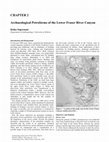
Introduction and Background For the past 5000 years, dense vegetation has dominated the coastal t... more Introduction and Background For the past 5000 years, dense vegetation has dominated the coastal temperate rainforest of the Pacific Northwest Coast, providing past inhabitants with an abundance of building material for housing, tools, clothing, and transportation (Ames and Maschner 1999; Moss 2011). Shell, collected from shellfish-abundant intertidal zones, was purposefully deposited to create stable, well-drained base for building large village locations (Martindale et al. 2009) and foundations for multi-family plank houses. Building with stone was limited, being primarily restricted to intertidal cobble and boulder petroforms related to fishing, shellfish gathering, and other beach clearing activity (Caldwell et al. 2010; Lepofsky et al. 2015; Menzies and Butler 2007). Recent work (Schaepe 2000, 2001, 2006) has identified a series of pre-contact petroforms built from stone in the Lower Fraser River Canyon (LFRC) (Figure 1) that differ from petroforms found in coastal intertidal zo...

Radiocarbon, 2016
Prince Rupert Harbour (PRH), on the north Pacific Coast of British Columbia, contains at least 15... more Prince Rupert Harbour (PRH), on the north Pacific Coast of British Columbia, contains at least 157 shell middens, of which 66 are known villages, in an area of approximately 180 km2. These sites span the last 9500 yr and in some cases are immense, exceeding 20,000 m2 surface area and several meters in depth. Recent archaeological research in PRH has become increasingly reliant on radiocarbon dates from marine shell for developing chronologies. However, this is problematic as the local marine reservoir effect (MRE) remains poorly understood in the region. To account for the MRE and to better date the Harbour’s sites, we propose a ΔR of 273±38 for the PRH area, based on our work at the site of Kitandach (GbTo-34), a massive shell midden-village centrally located within the Harbour. We followed the multiple paired sample approach for samples from specific contexts and ensured contemporaneity within the groups of marine and terrestrial materials by statistically assessing for outliers u...
Blurring Timescapes, Subverting Erasure
Archaeological Prospection
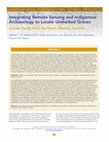
Advances in Archaeological Practice
Archaeologists have long been called on to use geophysical techniques to locate unmarked graves i... more Archaeologists have long been called on to use geophysical techniques to locate unmarked graves in both archaeological and forensic contexts. Although these techniques—primarily ground-penetrating radar (GPR)—have demonstrated efficacy in this application, there are fewer examples of studies driven by Indigenous community needs. In North America, the location of ancestors and burial grounds is a priority for most Indigenous communities. We argue that when these Indigenous voices are equitably included in research design, the practice of remote sensing changes and more meaningful collaborations ensue. Drawing on Indigenous archaeology and heart-centered practices, we argue that remote-sensing survey methodologies, and the subsequent narratives produced, need to change. These approaches change both researchers’ and Indigenous communities’ relationships to the work and allow for the inclusion of Indigenous Knowledge (IK) in interpretation. In this article, we discuss this underexplored...








Uploads
Peer Reviewed Publications by Kisha Supernant
Conference Presentations by Kisha Supernant
Papers by Kisha Supernant
Featuring plenary speakers Ben Alberti and Kisha Supernant with presentations from Oliver Harris, Sophie Moore, Rachel Crellin, Lindsay Montgomery, and Craig Cipolla